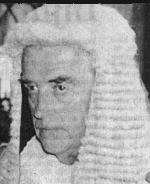Lord Lane's conduct in the Mycock case

This was a case of burglary in Manchester. Anthony Mycock had been convicted of breaking into a house and committing a burglary - solely on the word of the supposed victim, a woman called Anne Fitzpatrick. At Mycock's trial in Manchester, she pointed to him saying he had burgled her flat and tied her up. Since several witnesses attested to the fact that Fitzpatrick herself sold the "stolen" articles, the "Rough Justice " team had had little problem in showing Mycock's innocence.
Lord Lane wanted to believe Fitzpatrick - because she came to his court for the appeal of Anthony Mycock and told him numerous lies about Hill and Young. This was music to his ears. He wanted to believe her - yet he knew she had lied at Mycock's trial - and was even lying to him in the Court of Appeal. Not surprisingly, his final position on her credibility was ambivalent, even though it was crucial to the outcome of the appeal.
For example, he said of her evidence about the goods she said Mycock had stolen from her:
" We do not accept that she has no recollection of this box of records. She was not telling us the truth about this..... We content ourselves by saying that had the jury been aware of the unreliability which she demonstrated before us, the result might have been quite different."
Clear enough? The lady was a liar. She did not even tell the truth under oath in the Court of Appeal. However, the Lord Chief Justice claimed he could believe Fitzpatrick's uncorroborated word elsewhere in the appeal.
One effort to shore up her story shows just how far Lord Lane was ready to abuse the power of his court. Although he knew Anthony Mycock had to be set free, Lord Lane tried to bring Anthony Mycock's brother Gary into the story as an accomplice to the break-in. Gary had never been prosecuted. Fitzpatrick had told the trial jury that Anthony Mycock had had an accomplice - but her description of him was nothing like Gary. Nevertheless, Lord Lane tried to re-write history and at least prove a break-in by bringing Gary back into the frame - even though Gary had no benefit of legal advice or even knowledge of what was being said. Lord Lane effectively found Gary Mycock guilty of the crime. He said:
"The other remarkable fact is one which we have already mentioned, namely..., that Gaz or Gary Mycock had on the base or his left thumb a tattoo in the shape of a heart."
A ten year old child could have checked this. But Lord Lane didn't. He had already heard evidence on this from a policeman, Detective Sergeant Fury, who said:
" He has a tattoo on the base of his left thumb... looks something like a heart, I am not quite sure."
And that was good enough for Lord Lane.
In fact, D.S. Fury had not seen Gary Mycock close enough to examine his hands for two years - and Lord Lane knew it. Furthermore, Gary Mycock was outside the courtroom when D.S. Fury said these words. He available to the Court or Appeal and Lord Lane that too. But Gary Mycock was not called before the court so that his tattoo might be examined.
Some of this was even in written evidence before Lord Lane - but he ignored it. At the time of the original investigation Gary Mycock had been arrested with his brother and examined for tattoos - no such tattoo had been mentioned at that time, even though a tattoo was a key clue in the case.
Even a decade later. we can still discover the truth with our own eyes. Gary Mycock's tattoo is still available for inspection. It is not the "helmet" shape that Fitzpatrick described. It is not " something like a heart" as described by D.S. Fury. It is not "heart shaped" as described by the Lord Chief Justice. It is the four letters "A.C.A.B.". It means "All Coppers Are Bastards" - not an uncommon opinion around the Appeal Courts.
Click HERE to return to the biography of Lord Lane.
Click HERE to return to main page.